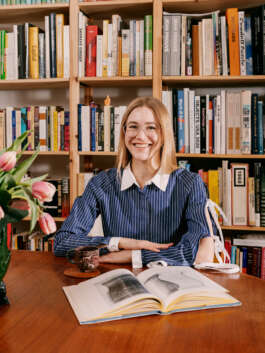



© Meghan Marin
COLLECTIBLE Three questions to
Hannah Martin
May 2025
Today we have the pleasure of speaking with Hannah Martin, the curator of the 2025 New York CURATED section. Drawing on her rich background in design storytelling and editorial work at Architectural Digest (US), she brings a nuanced lens to this year’s curatorial theme. In our conversation, she reflects on the historical and conceptual underpinnings of her vision for the CURATED section, shares what she hopes to see from designers this year, and offers insights into the evolving relationship between collectible design and decorative arts.
COLLECTIBLE: You’ve spent years exploring the intersections of design, culture, and storytelling — how has your background shaped the way you approached this year’s curatorial theme?
Hannah Martin : I like to look at contemporary design through the lens of history. And in my writing and editing at AD, these are the narratives that I always find most compelling. When I was thinking about ideas for a curatorial theme, I wanted to choose something that could tell a larger story about decorative arts and architecture, and how patrons over the centuries have expressed themselves and their ideas through the way they lived. A folly, or a purely decorative structure, felt like a perfect jumping off point. I’m interested in how ornament can be used to communicate complex ideas in contemporary design. And I like that the word itself—which brings to mind madness, extravagance, and fantasy—leaves room for interpretation.
C: The concept of the folly embraces both fantasy and contradiction. What kinds of proposals are you hoping to see from designers this year?
HM: I hope to see some less literal interpretations of the idea. We live in a moment where there is a lot of delusional thinking; where reality is becoming increasingly illegible, and I want the pieces in this show to comment on that in smart ways. I’d like to be deceived by the works. I’d like to be dazzled. I’d also like to see some shells.
C : As collectible design increasingly blurs the line between object and art, do you see today’s designers embracing the same spirit of extravagance—or even critique—that follies once embodied?
HM : A folly is, more or less, without a real purpose, even if its form alludes to one. This is something we’re seeing more and more in the collectible design market. We can no longer simply assume that a chair is intended for sitting. As functional forms ascend into the realm of sculpture, they can take on the role of the trojan horse–ushering in radical ideas while, simultaneously, blending in with the furniture. Interior follies, so to speak. I hope the pieces in the show can speak to and contemplate this blurry line.

© Meghan Marin
COLLECTIBLE Three questions to
Hannah Martin
May 2025
Today we have the pleasure of speaking with Hannah Martin, the curator of the 2025 New York CURATED section. Drawing on her rich background in design storytelling and editorial work at Architectural Digest (US), she brings a nuanced lens to this year’s curatorial theme. In our conversation, she reflects on the historical and conceptual underpinnings of her vision for the CURATED section, shares what she hopes to see from designers this year, and offers insights into the evolving relationship between collectible design and decorative arts.
COLLECTIBLE: You’ve spent years exploring the intersections of design, culture, and storytelling — how has your background shaped the way you approached this year’s curatorial theme?
Hannah Martin : I like to look at contemporary design through the lens of history. And in my writing and editing at AD, these are the narratives that I always find most compelling. When I was thinking about ideas for a curatorial theme, I wanted to choose something that could tell a larger story about decorative arts and architecture, and how patrons over the centuries have expressed themselves and their ideas through the way they lived. A folly, or a purely decorative structure, felt like a perfect jumping off point. I’m interested in how ornament can be used to communicate complex ideas in contemporary design. And I like that the word itself—which brings to mind madness, extravagance, and fantasy—leaves room for interpretation.
C: The concept of the folly embraces both fantasy and contradiction. What kinds of proposals are you hoping to see from designers this year?
HM: I hope to see some less literal interpretations of the idea. We live in a moment where there is a lot of delusional thinking; where reality is becoming increasingly illegible, and I want the pieces in this show to comment on that in smart ways. I’d like to be deceived by the works. I’d like to be dazzled. I’d also like to see some shells.
C : As collectible design increasingly blurs the line between object and art, do you see today’s designers embracing the same spirit of extravagance—or even critique—that follies once embodied?
HM : A folly is, more or less, without a real purpose, even if its form alludes to one. This is something we’re seeing more and more in the collectible design market. We can no longer simply assume that a chair is intended for sitting. As functional forms ascend into the realm of sculpture, they can take on the role of the trojan horse–ushering in radical ideas while, simultaneously, blending in with the furniture. Interior follies, so to speak. I hope the pieces in the show can speak to and contemplate this blurry line.
Contact
info@collectible.design
VIP PORTAL
EXHIBITOR PORTAL
PRIVACY POLICY
© 2025 Collectible
Contact
info@collectible.design
VIP PORTAL
EXHIBITOR PORTAL
PRIVACY POLICY
© 2025 Collectible